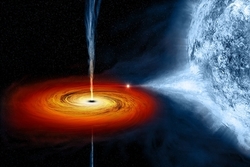Black Hole Identified #1
 Which of these choices could be a property of black hole?
Which of these choices could be a property of black hole?
This section requires Javascript.
You are seeing this because something didn't load right. We suggest you, (a) try
refreshing the page, (b) enabling javascript if it is disabled on your browser and,
finally, (c)
loading the
non-javascript version of this page
. We're sorry about the hassle.
4 solutions
Under ideal, non-rotating conditions, a star only slightly more massive than our own Sun can theoretically collapse into a black hole (see Chandrasekhar Limit), so that it doesn't take a "supermassive star" to "die" and form a black hole.
Black holes become supermassive because they keep on eating long after they're formed.
Secondly, we shouldn't speak of black holes as "dead stars"! The physics of black holes are so radically and dramatically different from any stars, dead or alive, that it's best to say that large black holes are usually the result of a gravitational collapse of a star. Lots of stars have other kinds of interesting deaths without turning into a black hole. Our sun will expire, become a red giant, and then shrink into a dwarf star, but so? And other black holes aren't necessarily the result of stars dying. For example, the LHC at Cern is believed to be producing microscopic black holes. No stars dying there!
Log in to reply
Do you mean antimatter? https://www.youtube.com/watch?v=PCuyCJocJWg << This is a link to a video on what is antimatter
It should be massive instead of giant. The red giants are not massive.
Log in to reply
Sir, I wrote Giant instead of Red Giant . Because the word was meant to be giant or, some kind of heavy .
OK sir, looks like this word has been ambiguous. I've modified the solution with your word massive . Now it looks nice.
Thank you sir!
Log in to reply
Giant refers to volume instead of mass.
Well this is not true because the black hole at the centre of the Milky Way is not a dead star
That's true, not all black holes are born from dead stars. But its more suitable than the other two choices.
When a massive star is dead it turns into a black hole
It stops producing hydrogen in to helium
See here Black holes
Actually it cant be seen as it cant let the light out......it has bery intrudting facts that ehich star can form blackhole etc
A nice tiny solution.
When a massive star has no more Hydrogen Fuel for the fusion reaction, its lifetime ends.
Its enormous gravity comprsses it so much that it becomes a Black Hole .
So, a Supemassive Star dies, giving birth to a Black Hole !